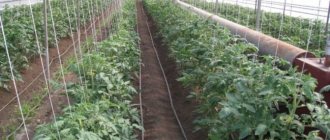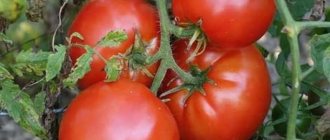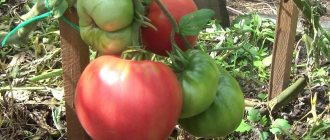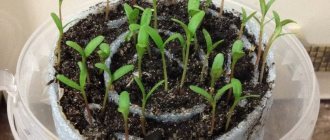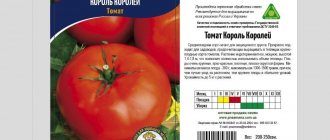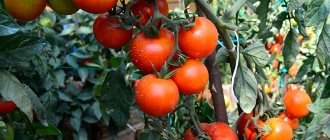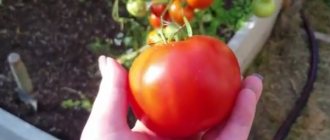Every gardener knows how much work and time needs to be spent for a bountiful tomato harvest. Growing this vegetable in our country, especially in central Russia and the Siberian region, is not easy: nightshade bushes and fruits are often affected by plant parasites, viruses and fungi, and weather conditions do not always allow for a full harvest.
Knowing the difficulties of growing tomatoes, breeders are constantly developing new varieties and hybrids that are resistant to pests and diseases. The Japanese succeeded in this. In 2009, she released a hybrid tomato variety, Pink Paradise, which is distinguished by its unpretentiousness and ease of care.
Description of the variety
Tomato variety Paradise f1 is a hybrid. It first went on sale in 2009, but this tomato appeared on the markets of our country much later.
This is interesting! Hybrids are created by crossing several different varieties. Breeders try to put all the best qualities of the “mother” plants into such crops.
Culture is indeterminate. It has constant growth and can reach a height of 2 m, and this must be taken into account when growing tomatoes in greenhouses and greenhouses. For Russian conditions, the manufacturer recommends growing the variety there - this will make it easier to care for the tomato and give a rich harvest.
It is possible to plant these tomatoes in open ground. In this case, the tomato bushes will need more careful care.
Reference. Even an amateur gardener can handle caring for this hybrid.
A photo of this tall bush clearly demonstrates the characteristics of the variety.
Characteristics
Pink Paradise is a hybrid variety of pink tomato.
It is distinguished by excellent taste and large, almost identical fruits, with an average amount of pulp and four chambers. Tomatoes of this variety are best suited for consumption raw, but they are also used for storing for the winter. Therefore, Pink Paradise tomatoes can be called universal.
This is interesting! The designation f1 indicates that Pink Paradise is a first generation hybrid.
The main feature and advantage of the Japanese tomato is its resistance to many pests and diseases. This allows you to reduce the amount of plant processing products and obtain a high-quality and healthy harvest.
Characteristics of Pink Paradise
Before you buy Pink Paradise tomatoes, you need to familiarize yourself with the features and characteristics of this variety.
Characteristics and description of the variety:
| Parameter | Indicators |
| Bush type | Indeterminate. Bush with constant growth. Can reach 2 m. The stems are powerful, with a lot of greenery. |
| Growing method. | It is recommended to grow in film greenhouses. It is possible to grow it in open ground, with the risk of deterioration of the qualities inherent in the hybrid. |
| Productivity | From one sq. m on average, 4-6 kg of crop is harvested. With proper care, the results can be higher. |
| Fruit | Pink with a uniform shade of skin and pulp. Juicy, have medium meatiness. They have a round, slightly flattened shape with slight ribbing at the base. The taste is sweetish. The skin is delicate but durable. The fruits are large, four-chambered and can reach from 150 to 200 g. |
| Transportability | Excellent. The fruits can be stored for 2-3 weeks. They do not crack and do not lose their presentation. |
| Ripening time | Mid-season hybrid variety. The first harvest appears 100-120 days after planting. |
| Disease resistance. | The hybrid is not susceptible to tobacco mosaic virus, brown and gray spot, cladosporiosis, root nematode, fusarium wilt, and verticillium wilt. |
What to consider when planting a crop
In the vast majority of cases, Pink Bush F1 tomatoes are grown in seedlings. It is at this stage that plants require the most attention from the gardener. The manufacturer indicates on the package of seeds that it is advisable to plant the seedlings in a permanent place when they reach the age of 35–45 days. When choosing a specific date, consider the climate in the region. If it is moderate, it is recommended to transfer tomato seedlings to the greenhouse in early May, and to open ground at the very end of spring or early June.
It doesn’t matter whether you use store-bought or self-prepared soil for seedlings. When growing the Pink Bush F1 hybrid, be sure to add sifted wood ash, crushed chalk, and activated carbon (at least a tablespoon per liter) to prevent fungal diseases
Wood ash is not only a natural source of potassium, but also an effective means of preventing fungal diseases, especially rot
Pink Bush F1 tomato seeds do not require preliminary preparation. The manufacturer has already taken care of everything in advance, so when planting they do not need to be soaked, disinfected, treated with biostimulants, and so on. It is enough to simply inspect them, rejecting those that are clearly damaged. Only the substrate will have to be disinfected.
Pink Bush F1 tomato seeds have already been pre-treated against diseases and pests
When preparing to grow hybrid seedlings, keep in mind that humidity levels, temperature conditions and lighting are critically important for them:
- The seeds are laid out using tweezers on moderately moist soil in containers. Cover the top with a layer of peat about 1 cm thick, sprinkling it with water from a spray bottle.
- Be sure to maintain an interval between seeds of at least 3-4 cm. If you place them closely, this provokes upward growth. And the stem of the Pink Bush F1 hybrid must be powerful and low, otherwise the plant simply will not support the mass of fruit. The same applies to already picked seedlings. Do not place the cups too tightly - the plants shade each other and stretch upward.
- Containers must be covered with glass or plastic film and ventilated daily for 5–10 minutes. The temperature is maintained at 25°C.
- After seedlings emerge, seedlings need light for at least ten hours a day. In most regions of Russia, this is only possible if additional lighting is provided. The temperature during the first week is no more than 16°C during the day and about 12°C at night. After a week, the next month it is raised to 22°C and maintained at this level around the clock.
- Water the seedlings exclusively with soft water heated to a temperature of 25–28°C as the substrate dries 1–2 cm deep. Be sure to settle tap water or add a little apple cider vinegar or citric acid to soften it. You can also use spring and melt water.
- After a month, harden the seedlings. Start with 1-2 hours of exposure to fresh air, but in the shade. Gradually extend this time to 6-8 hours. In the last 2-3 days before planting, leave the tomatoes to “sleep” outside.
Video: growing tomato seedlings
Pink Bush F1 tomato seedlings ready for planting have 6–9 true leaves and 1–2 future fruit clusters. Don't delay disembarkation. If flowers and especially fruit ovaries appear on the plants, they are not guaranteed to produce a bountiful harvest. The dimensions of the bushes allow you to place 4–6 plants per 1 m². Plant them using the transshipment method, in a checkerboard pattern, to ensure even access to the sun. It is impossible to thicken plantings excessively, as this provokes the appearance of diseases and inhibits the development of bushes. After planting the seedlings, water them moderately, mulch the bed and forget about watering and loosening for the next 10 days.
Pink Bush F1 tomato seedlings must be transplanted to a permanent place on time, otherwise the plants will not bring a bountiful harvest
Take care of preparing the bed or soil in the greenhouse in advance. For Pink Bush F1 to perform at its best, the substrate must be nutritious and fertile. Be sure to add humus, nitrogen-containing, potassium and phosphorus mineral fertilizers. The hybrid categorically does not tolerate acidic soil. Dolomite flour, crushed chalk, and slaked lime will help normalize the acid-base balance.
Dolomite flour is a natural soil deoxidizer that does not have any side effects if the dosage is observed.
Garlic is a very suitable neighbor and predecessor for Pink Bush F1 tomatoes
When planting the Pink Bush F1 hybrid, provide space for something like a trellis. You will have to tie fruit clusters to it. In a greenhouse, bushes that grow higher than normal will require full support.
Growing seedlings
If you decide not to buy ready-made seedlings from experienced gardeners, but to grow bushes from seeds yourself, learn the basic rules for such work. High-quality seedlings are the key to a healthy plant and a rich harvest.
The seedlings are sown at the end of February. Experienced gardeners advise doing this according to the lunar calendar.
Preparing the seeds
Before you start working with seeds, make sure that their expiration date has not expired - old material has low germination rates.
Seed preparation:
- Sort out the planting material. Discard damaged seeds covered with mold and fungus.
- There is no need to disinfect seeds. The manufacturer carries out all the necessary manipulations to protect the material from disease.
- To speed up seed germination and increase their germination capacity, treat them with a growth stimulator. The material is soaked in a special liquid (for example, Epin) for 12 hours.
- After soaking, remove any seeds that float to the surface. The chances of them germinating are low.
Advice! If you sow seeds that are not soaked in a growth stimulant, they will also sprout. But the germination of the material in this case will occur more slowly.
Selecting container and soil
The choice of container for germinating seeds is not very important. For these purposes, it is most convenient to use long plastic trays or wooden boxes. Some gardeners plant seedlings in cut-off five-liter bottles or juice packaging.
When the seedlings germinate, each plant is planted in individual containers. For these purposes, it is better to use small peat pots, disposable cups, etc.
To grow seedlings you need a properly prepared soil mixture.
There are two ways to prepare it:
- Purchase the ready-made mixture at a specialty store. Such soil has an ideal composition, including the substances necessary for the full development of seedlings.
- Preparing the soil yourself is a more budget-friendly and reliable option. To make fertile soil, mix two parts peat with one part turf soil and one part humus. You can add ash and a little superphosphate to this mixture.
Advice! To save money, gardeners mix purchased and self-prepared soil in equal proportions.
Both purchased and homemade soil may contain insects and bacteria that are dangerous to seedlings. Therefore, before use, the soil must be treated with a light pink solution of potassium permanganate.
Sowing seeds
The seeds are planted in a large container. They are buried 1.5 cm into the ground.
The top of the seedlings is covered with film. The container is placed in a place well illuminated by sunlight, for example, on a windowsill. The optimal temperature for growing is +25 degrees.
To avoid moisture stagnation, seedlings must be ventilated regularly. To do this, it is enough to open the film for several hours in the warm time of the day.
Rules for growing seedlings
The germination of seeds and the health of the plants depend on the correct care of seedlings. There are several important rules for picking tomatoes.
Rules for growing seedlings:
- The soil is moistened as it dries, always through a spray bottle. It is important to use water at room temperature.
- It is necessary to constantly maintain optimal temperature and humidity levels for plants.
- When real leaves appear on the tomatoes, they are planted in individual pots. It is better to use peat containers.
- When the transplanted plants take root, feed them with complex fertilizers.
- Seedlings in separate pots are watered from a watering can. The frequency of watering depends on how quickly the soil dries out.
- Two weeks before planting seedlings in open ground or a greenhouse, it is necessary to harden them. To do this, pots with plants are placed outside every day during the warmer months. First, the tomatoes are taken out into the fresh air for a couple of hours, then this time is gradually increased.
Transferring plants to a greenhouse
For tall varieties such as Pink Paradise, staggered planting is usually used. This diagram shows planting for 32 bushes, but it can be adjusted depending on the required number of plants.
Landing instructions:
- Planting begins in May. By this time the beds should be ready. The height of the beds should not exceed 40 cm, and the approximate width should be 60-65 cm. The passage should be no more than half a meter wide.
- Holes are made in the beds. In this case, the distance between the rows should be from 80 cm to a meter, and the distance from one hole to another should be 70 cm.
- Immediately before planting, the soil must be treated with a solution of potassium permanganate and copper sulfate.
- The plants themselves, before being planted in the greenhouse, are watered with phytosporin.
- When tomatoes are planted in a hole, each bush must be tied to a long stake strong enough to support the plant.
- After this, each bush needs to be watered.
Growing tomatoes
For Pink Paradise, the manufacturer recommends using greenhouses. A greenhouse in the garden can also be a suitable option for Japanese tomatoes.
Advice! If you want to get a good harvest, it is better to grow seedlings yourself. Unscrupulous sellers may sell cheaper varieties under the guise of an expensive Pink Paradise hybrid.
Landing in the ground
Tomatoes need to be planted in May, in the last ten days. At this time, the soil has time to warm up to the required temperature.
For better growth of tomatoes, add ash and compost to the holes in which they will be planted. Plants are buried down to the first cotyledon petals to form additional roots.
It is important to maintain a distance between bushes - 60 cm and 40 cm between rows. The tomato stem is tied to a wooden support.
The first watering of plants is carried out a week after planting the seedlings in the ground. At the same time, you can make the first fertilizing.
Advice! If you plant tomatoes in open ground, then at first it is better to keep the plants under a film, periodically ventilating them.
Rules of care
Tomatoes are grown with one or two stems. In the first case, the harvest will appear two weeks earlier, and in the second it will be possible to get more fruits.
Rules for feeding Pink Paradise tomatoes:
- The tomatoes are fed for the first time a week after they are planted in the greenhouse. For this purpose, nitrogen fertilizers are used.
- To increase the quantity and quality of ovaries, potassium and phosphorus fertilizers are used. After two weeks, a second feeding is introduced.
- Foliar feeding can also be done. For this, boric acid is used.
Paradise Peak - self-pollinating tomatoes. To speed up fruit set, the bushes need to be gently shaken every morning.
It is important to plant the bushes. Otherwise, instead of a bountiful harvest, you will get a lot of greenery. After the formation of six full-fledged hands, you need to limit the growth points.
During the pinching process, the lower leaves and overgrown shoots are removed. This must be done regularly and carefully.
Water the tomatoes regularly, without flooding the bushes. On the day of removal of leaves and shoots, no watering is performed to avoid infection of the injured areas.
The nuances of growing Pink Paradise tomatoes in a greenhouse and in open ground
The manufacturer recommends growing Pink Paradise in greenhouses or greenhouses. In such conditions, plants will produce the best harvest.
Caring for Japanese tomatoes in greenhouses is not associated with any difficulties. All that is required from the gardener is regular watering, tying and pinching.
Planting Pink Paradise tomatoes in open ground is possible. The manufacturer warns that in this case, a deterioration in the quality of the hybrid is likely.
In soil conditions, it is necessary to bring the conditions as close as possible to greenhouse conditions. To do this, it is advisable to cover the bushes with film at night, creating a greenhouse effect.
The risk of late blight infection increases when Pink Paradise is grown in open ground. Therefore, in rainy weather, even unripe fruits are collected.
Farmers who have tried both methods of growing tomatoes say that the hybrid produces the most abundant harvest when grown in a greenhouse. In such conditions it is rarely affected by phytovtora.
Pests and diseases
Pink Paradise is resistant to most plant diseases, which significantly reduces the number of necessary treatments. Therefore, even a beginner should not have problems caring for this variety.
Plants can be attacked by harmful insects. Therefore, bushes need to be regularly inspected and garden pests collected. To scare them away, spray your tomatoes with soapy water.
Regular removal of weeds will not only ensure normal growth of the plant, but also protect it from mole crickets. Slugs are afraid of the composition of a spoonful of red pepper added to a bucket of water.
To avoid infection of plants with late blight, starting in July, they are treated with a systemic fungicide every two weeks. Two weeks before harvest, procedures are stopped.
Reviews of tomato Pink Paradise
I’ve been planting Pink Paradise for 3 years in a row, the yield is average, but the taste is amazing, sweet and juicy. Next season I want to try to form this tomato into two stems.
Malina Soroka
https://forum.prihoz.ru/viewtopic.php?t=5055&start=225
I consider the Pink Paradise hybrid to be outstanding - large pink beef tomatoes of excellent taste and yield. They don't crack at all.
Mopsdad
https://forum.vinograd.info/showthread.php?p=135167
When ripe they are very beautiful, bright pink. Mostly smooth. The taste of these tomatoes is simply amazing. All customers come back again and ask for this particular variety. It transports very well. Light enough.
Nope
https://otzovik.com/review_3484999.html
Every season I plant a couple of hybrids. This is where Pink Paradise and Bobcat grew up. I'm delighted with Bobcat. Very productive and most importantly delicious. Got there quite early. At the beginning of the season, Pink’s yield was not very good, but then he warmed up and put on a lot of tassels. I showed it before harvesting, absolutely clean and healthy leaves. It’s interesting that the higher the tomatoes grew, the stronger their nose formed, although this does not seem to be typical for a hybrid.
Amaranth
https://forum.tomatdvor.ru/index.php?topic=4857.0
We grew Pink Paradise for 2 years, excellent tomatoes. Productivity, taste, appearance, everything is super. BUT we can’t get it early, it’s average.
Natalie
https://forum.tepli4ka.com/viewtopic.php?f=18&p=24083
Collection and use of fruits
Harvesting begins after the first fruits ripen. Regularly in the morning you need to use scissors to remove all ripe fruits from the bush. Harvest continues until low temperatures.
In rainy weather, you can also pick large green fruits. They will ripen with the stalk even at home.
Pink Paradise tomatoes have a sweet taste. They are mainly consumed fresh. They also make puree and tomato juice.
The main advantages of the hybrid
Most vegetable growers who have tested this variety on their plots note the following positive qualities of the plant:
- High yield.
- Good tolerance to temperature changes (except frost).
- Low maintenance requirements.
- Excellent taste of the fruit.
- Resistance to various tomato diseases.
A disadvantage of the variety is the need for careful thinning of the bush, since when grown in a greenhouse, plants can shade and suppress each other.
Pick up plants after 3-4 true leaves appear
| Stage 1. Purchase of high-quality planting material Step 1. This is a hybrid variety, so you won’t be able to collect the seeds yourself. They must be purchased every year. Step 2. It is best to purchase seeds from the originator - the Sakata company, but they are sold in large packages. Therefore, buy options packaged by well-known seed companies | |
| Stage 2. Preparation for sowing Step 1. The seeds are treated with Thiram, so disinfection in potassium permanganate is not required. But you can use a growth stimulator to make plants grow better. Step 2. Purchase soil for seedlings at a gardening store. For planting, prepare a container of a suitable size. The optimal period for work is mid-March | |
| Stage 3. Sowing seeds Step 1. Lay out the seeds in increments of 2-3 cm, the distance between the rows is 4-5 cm. Cover them with a layer of soil no more than 1 cm. Water generously. Step 2. Place the container in a place with a temperature of about 25 degrees. After germination, move the container to the windowsill | |
| Stage 4. Picking Step 1. After two or more true leaves appear, plant the tomatoes in separate containers with a volume of half a liter to a liter. They will not interfere with each other and will develop better Step 2. When replanting, pinch the central root. This stimulates the development of lateral processes | |
| Stage 5. Caring for seedlings Step 1. Spray the plants with warm water in the morning and evening. Water about once a week. Step 2: Fertilize the seedlings every 3 weeks. Use ready-made mineral compositions. Step 3. 10 days before planting, begin hardening off the seedlings. Take it outside or leave it near an open window for 3-4 hours |
Video
For a detailed video review of growing the Pink Paradise tomato variety, see below:
In the table below you will find links to other varieties of tomatoes presented on our website and having different ripening periods:
| Early ripening | Mid-late | Mid-early |
| Raspberry Viscount | Yellow banana | Pink Bush F1 |
| The Tsar Bell | Titanium | Flamingo |
| Kate | Slot F1 | Openwork |
| Valentina | Honey fireworks | Cio Cio San |
| Cranberries in sugar | Miracle of the market | Supermodel |
| Fatima | gold fish | Budenovka |
| Verlioka | De Barao black | Major F1 |
Treat with a fruiting stimulator during flowering
| Stage 1. Planting seedlings Step 1. The recommended planting period is the second half of May. Pre-prepare the soil - apply fertilizer and dig. Step 2. Plant tomatoes according to a 60x70 cm pattern. After planting the seedlings, be sure to water them | |
| Stage 2. Watering Step 1. A day before work, pour water into containers to let it settle and heat up. Step 2: Water the plants in the evening after sunset about once a week. Use 5-7 liters of water per bush | |
| Stage 3. Loosening and weeding Step 1. Loosen the soil around the plants after each watering. It is convenient to use special rippers as in the photo. Step 2: Weed twice a month | |
| Stage 4. Tying Step 1. It is recommended to drive in pegs when planting seedlings and immediately fix the plants so that the stem does not bend. Step 2. As the bush grows, tie it up in 2-3 more places so that the plant does not bend under the weight of the tomatoes. | |
| Stage 5. Feeding Step 1. Use special complex formulations for tomatoes. The originator of the variety recommends them. Step 2: Apply fertilizer at the root once a month. After this, be sure to loosen the soil | |
| Stage 6. Timely harvesting Step 1. Remove the fruits as they ripen so that the plant does not waste nutrients on them. Step 2. Be sure to remove damaged and rotten fruits from the garden |
Proper care
The rules for caring for Pink Paradise are standard, like any other tomatoes. The only difference is forced pollination. To do this, move the stems during flowering so that the leaves touch each other. Then you will get a rich harvest.
Watering
Moderate watering is required. Due to a lack or excess of moisture, the external and taste qualities of the vegetable crop will deteriorate, and the crop will die. Therefore, the soil must always be moist.
Stepping and support
A grown bush will need strong support for proper development and growth. It is worth tying the trunk to it. Pinching occurs by cutting one of the stems. Which will increase the size of the yield.
Feeding
Nitrogen fertilizers should be applied before fruits appear. After their appearance - potassium-phosphorus. And periodically - a growth stimulator in the form of succinic acid.
